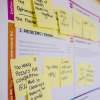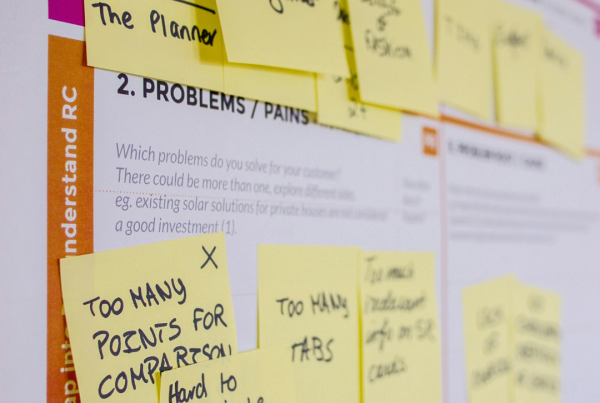As a startup, it’s crucial for you to deliver a product that meets market needs. After all, one of the biggest reasons startups fail is because they built a product that didn’t solve any problems or wasn’t significant enough to attract many users to sustain a business.
Some of the clients I’ve consulted for were strapped with minimal budget and resources, and I understand how crucial it is to get it right off the bat. In this article, I’ve outlined several tips to help you find a market need and design a market-fit product quickly and efficiently.
Tip 1: Adopt a Mindset Geared Towards Iterative Improvements
Whichever method you want to adopt, it all boils down to the same thing:
- Test your ideas or assumptions with your users.
- Design or improve your product/prototype based on tests and feedback.
- Rinse and repeat.
Whether you’re going with design thinking strategies, the lean product process, or other methods recommended for startups, most would preach similar things. Changing your mindset and strategy to incrementally build, test, and improve your product is the safest and quickest way to find a market-fit product without spending a fortune and wasting resources.
Tip 2: Gauge the Market Demand on Platforms Like Kickstarter
If you’ve got a somewhat original idea that you feel isn’t fully offered in the market, try checking out platforms like Kickstarter. It’s not for copying ideas, but for understanding the reception that those ideas are receiving. You’ll be able to see if an idea or project has received a lot of funding and be able to roughly assess the market demand for ideas similar to yours.
Tip 3: Find Existing Data on Your Targeted Users
If there’s plenty of data or research on your target market’s behaviour, preferences, and market potential, then use those figures to guide you. Trawl through published reports, read online forums and communities to understand your users better, go through relevant content online or on social media, and look at stuff your competitors are publishing too.
Tip 4: Run Your Own Research
You should also be running your own research, such as polls, surveys, focus group sessions, and user testing. There are a lot of free tools to run surveys and tests. They’re not tedious to use and will certainly help you understand whether your product idea and design is working. Another trick is to do guerrilla testing on your prototype, which is testing with the general public instead of invited or recruited users. Find a public spot, get out there, start talking to people, and get their quick feedback on your prototype. It’ll help you discover what’s missing from your idea.
Tip 5: Don’t Seek Validation; Seek the Truth
When you’re in research and testing mode, do it to discover the truth. One common mistake that founders make is that they’re too in love with their idea or product and start to develop a bias to accept results that agree with them and filter out those that don’t. You can be building something for yourself as a target user, but keep in mind that you are only one user among thousand other users that you are hoping to attract.
Tip 6: Snoop on Your Competitors
Study the products that are doing well in the market and the ones that aren’t. Check out the product offerings, their demographic of users, their pricing models, and how they gain users. You’ll want to look at their user reviews too, such as the ones available on app stores and websites. Read what people say on online forums and social media groups too; there are plenty of honest opinions there.
If you don’t learn from history, you’ll end up repeating the same mistake. Study past entrants in the market, and understand why they failed. For example, multiple video-sharing apps such as Vine were in the market years before TikTok blew up. One of the reasons others failed was that the content hosted wasn’t entertaining enough to make people want to jump on the bandwagon and share it with others. Past competitors also had weaker feature sets.
Tip 7: Separate Your User Problems and User Solutions
For you to create a product that’s market-fit, it’s essential to keep the problem separate from the solution. I know it’s tempting to jump straight into designing a solution, but you’re doing your product a disservice.
In the user problem space, you should be identifying customer needs and how urgent those needs are, and you’ll typically start with a blank slate. Your current product or preconceived idea for a product shouldn’t affect this process. In the user solution space, you’ll be designing the best way to help meet those needs or solve those issues. Keeping them separate will help you make better product improvements, or help you pivot the product to something that more meets the market needs.
Tip 8: Consider That Your Users May Not Be The Decision Makers
One thing to keep in mind is that the users who use your product may not be the ones who decide to buy your product or hire your service. Typically, products targeted at kids have this kind of scenario, so you need to think about solutions that will attract kids and also convince parents that your product is safe for kids, entertains or helps their kids, and provides value for the parent’s money.
Another example is a product targeted at households, where there may be two people making the decisions, a husband and wife or partners with opposing needs. B2B products also need to please financial decision-makers, not just the teams that use them.
Tip 9: Figure Out Your Product’s Edge
One common misconception is that your product needs to be better, faster, and generally superior to other products. As a startup, this might overwhelm you, and eventually flow down to your product, making it bloated and complex. There are different ways to differentiate your product so that it is unique in the market. There are several differentiation strategies:
- Pricing differentiation: Your product may be similar to others but is offered at a much lower price point, attracting a unique set of demographics.
- Service differentiation: Your product does what others do, but users get much better service in terms of delivery, convenience, and after-sale support.
- Niche differentiation: Your product targets a niche that is underserved in the market, catering to their exact needs.
- Quality differentiation: Your product is of higher quality and offers better features, and this is evident among other competitors that users are willing to switch or pay a premium for it.
Tip 10: Test Your Marketing Too
In a competitive industry, you need to know how you are going to attract users, just as much as you need to know how to build a market-fit product. It’s easy to think that if you build a market-fit product, users will just gravitate toward it. Marketing is an essential component for startups to gain traction quickly, so don’t forget to focus on this.
You can try testing your marketing materials, such as a landing page or ad. Check the click-through rates, conversion rates, and other metrics. Ask for feedback from visitors about whether they understood the marketing content or the value proposition you are trying to sell.
Tip 11: Stay Up to Date with Your Industry
If you’re competing in a heavily regulated industry such as finance or healthcare, you should stay up-to-date with any changes and regulations that will affect your product. Even in a less regulated space, you still need to understand consumer laws and privacy regulations concerning user data. As a startup founder, you’ll be constantly pulled in one direction or another, and you don’t want to get caught out for something that was easily prevented.
Image by rawpixel.com on Freepik







